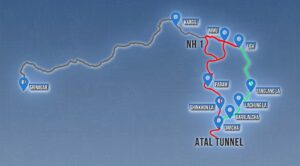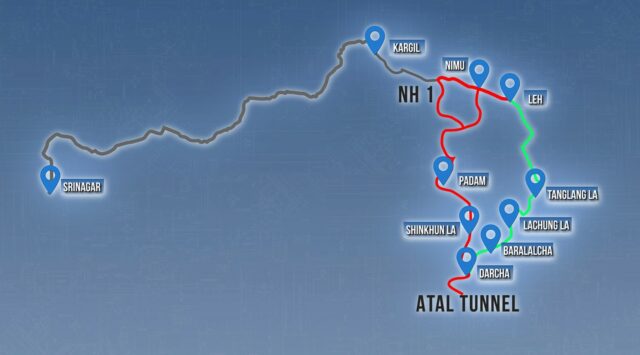NEW DELHI: Nearly 10 days after National Security Adviser (NSA) Ajit Doval’s hour-long one-on-one meeting with Russia’s President Vladimir Putin in Moscow, the buzz in strategic circles, both in India and across the globe, about that rare event refuses to ebb because Putin normally doesn’t meet anyone other than Heads of State.
In the wake of the meeting on February 10, two immediate conclusions are self-evident. One, Putin granted Doval a private meeting for over an hour since he understands India’s importance in keeping open the communication channels between Russia and the West. And two, and perhaps more significantly, the meeting also demonstrates Doval’s high standing amongst national security professionals across the world and Prime Minister Narendra Modi’s complete trust in his abilities. It is no secret that the India-Russia relationship over the past few years is primarily driven by Doval and his good friend Nikolai Patrushev, Putin’s security czar.
Former diplomat MK Bhadrakumar, not someone who compliments policies or individuals easily, also could not refrain from flagging the importance of the meeting in Kremlin. “It (the Putin-Doval meeting) was an exceptional event. Putin’s meeting with Doval signified two things — it was a recognition both of Doval’s unique standing as a meaningful interlocutor in the Indian government as well as his standing as an accomplished professional with vast experience in the regional security issues, in particular, Afghanistan,” Bhadrakumar remarked in a recent commentary.
The timing of Doval’s meeting with Putin is also not lost on anyone. The Indian NSA met Putin, barely a week after his series of high-level meetings in Washington DC where he led the Indian side to discuss the Initiative on Critical and Emerging Technologies (ICET), agreed upon between Modi and President Joe Biden last year. Details about what Putin and Doval discussed are not available but it is fair to conclude that the two would have discussed Russia’s ‘Special Operations’ in Ukraine and the West’s view of the situation in Ukraine besides the state of India-Russia special and privileged strategic relationship and the situation in Afghanistan.
Doval’s trips in February—Washington, London and Moscow (publicly known) and a couple of unannounced ones in the near neighbourhood—is indicative enough of the workload he carries in keeping India’s foreign policy and strategic affairs on an even keel but a quick assessment of some of the steps taken by the National Security Council Secretariat (NSCS) under his leadership in the past four or five years, also demonstrates the Modi government’s laser sharp focus on strengthening various aspects of national security by focusing on both micro and macro issues.
One instance readily comes to mind in the context of last week’s approval accorded by the Cabinet Committee on Security (CCS) to the construction of a 4.1 long tunnel at Sinku La on the recently opened Darcha-Padum-Nimu-Leh road that provides a third alternative road access to Ladakh. The tunnel, to be completed latest by 2025 will cost ₹1600 crore plus to build but more importantly will allow year-round connectivity to Ladakh unlike the other two roads between Srinagar-Leh and Manali-Leh, which get blocked for over three-four months during winter due to excessive snowfall at high altitude passes (Zozi La, Baralach La, Lachung La and Tanglang La) on these routes.

Once the tunnel comes up at Sinku La, the Indian Army will be able to have an all-weather access to Ladakh for the first time since Independence, boosting India’s military preparedness against China in Eastern Ladakh, thereby strengthening deployment in the high-altitude areas along the Himalayan border. There is a back story to how this approval came about.
The proposal to build this tunnel was mooted more than a decade ago by the Army’s Northern Command. The logic was simple: On the Darcha-Padum-Nimu axis, construction of the Sinku La tunnel would be sufficient to make the road accessible all year round as compared to constructing three longer and consequently more expensive tunnels at Lachung La, Baralacha La and Tanglang La (see map).
The proposal was being tossed around by officials in the Ministry of Defence (MoD) and the Ministry of Road Transport and Highways (MoRTH), each ministry expecting the other to fund an assessment study, leave alone sanctioning the tunnel. A senior Army officer, aware of the criticality of the tunnel, then took the initiative to informally reach out to the NSA to force an early decision. What trajectory that proposal took and how much persuasion and follow up was required to finally get the CCS clearance may perhaps never be known but as the military officer concerned, by now happily retired, mentioned last week, had it not been for the NSA’s personal intervention, this project would still be languishing in the files.
At the same time, the NSCS under Doval’s leadership has kept its eyes firmly on the ‘big picture’ both on conception and implementation of different policy reforms in the national security domain. Accordingly, the key objective of the reorganisation was identified as streamlining the functioning of the NSCS to ensure effective policy making in a fast changing global security environment to meet contemporary and future requirements. The thrust of the initiative was to identify ways to ensure close coordination between NSCS and ministries/Attached Offices. The overall goal was to help create a composite picture on national security issues within government without in any way interfering with the executive functions of line ministries.
The key features of the reorganisation included the following:
- · Restructuring of the NSCS.
- · Institutionalising roles and functions of the NSCS by inclusion in Allocation of Business Rules.
- · Ensuring greater awareness within government about the new roles and functions of the NSCS.
- · Identifying areas of focus for creation of appropriate human resource potential.
The most significant aspect of the reorganisation of the NSCS was the creation of four Wings: Strategic Affairs (SA), Internal Affairs (IA), Technology & Intelligence (T&l) and Military. The SA, IA and T&I Wings were to be headed by a Deputy NSA (DNSA) and military affairs coordinated by a Military Adviser (MA).
The SA Division is supposed to deal with International Affairs including projects of strategic importance in India’s immediate and extended neighbourhood. In addition, a new Maritime and Indo-Pacific Affairs Division was created within the SA vertical to provide focused attention on all dimensions of maritime security. The IA Division is mandated to look at both traditional and next generation internal security threats. It would also work with MHA to monitor strategic border infrastructure projects.
The new T&l Wing has the responsibility to take a comprehensive approach towards Technical Intelligence (TECHINT), cyber security and futuristic technologies in both civilian and military domains. The National Cyber Security Coordinator (NCSC) is a part of the T&l Wing. For futuristic defence technologies, the T&I Wing works closely with the Military Wing. This also helps create civil and military fusion to the extent possible. These structural inter-linkages within the NSCS have facilitated coordination within the government to create policies in line with the global trend of distributed production, ensuring availability of adequate resources and integrity of supply chains.
The Military Wing рауs special attention to the neighbourhood, monitors implementation of a National Defence Strategy, works closely with the defence industry and suggests ways to ensure adoption of modern military technology development techniques.
NSCS was also included in the Allocation of Business Rules, thereby institutionalising the new structures and its roles and functions. The NSCS is now mandated to assist the NSA, who is the Principal Adviser on national security matters to the Prime Minister and the NSC. It also services the work of the NSC, SPG, NSAB and other specialised structures like the National Information Board (NIB) and the Technology Coordination Group (TCG).
As part of the reorganisation, the reconstituted SPG now functions under the NSA and the Cabinet Secretary is member of the SPG. The SPG functions as the principal mechanism for inter-ministerial coordination and integration of inputs to formulate national security policies. It is a unique forum that brings together diverse stakeholders including Vice Chairman NIT Aayog, Governor of RBI, Chiefs of Defence Services, Secretaries of all important security related Ministries and the Intelligence Chiefs. As is well-known, a Defence Planning Committee (DPC) was also created in 2018 under the Chairmanship of the NSA to integrate relevant inputs in the formulation of holistic national security policies.
As India’s longest serving NSA, Doval has led the way in creating new structures to contribute more meaningfully to the objectives defined by the government. Therein lies his importance to Prime Minister Modi.
















